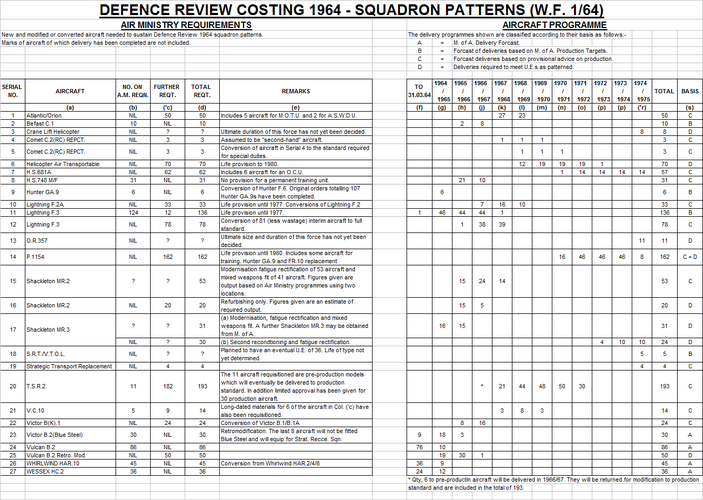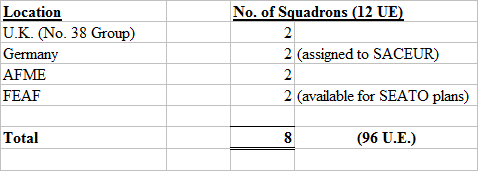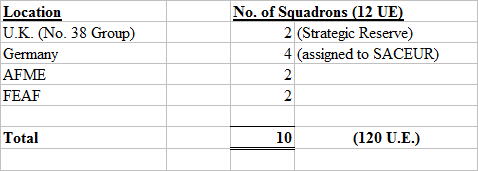I believe that a force of 3 CVA,01 class strike carriers (2 active and one refit/reserve with 2 air groups of Phantoms, Buccaneers and Hawkeyes) could have been afforded until the middle of the 1980s using the money that was spent on the Invincible class, the RAF's maritime force of Buccaneers, Phantoms & Shackletons, the Sea Harrier and the AEW Nimrod.
However, I also think it's more realistic in a situation where the British economy performs better from February 1966 onwards. (Don't ask me to explain how & why it does because I can't.)
In the situation I'm thinking of the February 1966 White Paper concedes that strike carriers are very useful in places other than East of Suez and that the marginal amount of money saved by replacing them with shore based aircraft is not worth the loss of their operational advantages. Therefore, the existing strike carriers would not be retired in 1975 and replaced by shore-based aircraft operated by the RAF. Instead Ark Royal (IV), Eagle & Hermes or Victorious were to be retained until until they could be replaced by 3 ships of the replacement class which would be built half-a-decade later than previously planned.
The replacement class was the GT-powered version of the CVA.01 class already discussed. 3 ships would be built instead of the real world Invincible class. They would be named Indomitable (CVA.01 built instead of Invincible), Implacable (CVA.02 built instead of Illustrious) and Indefatigable (CVA.03 built instead of Ark Royal (V)).
The 1967 decision to withdraw British forces from East of Suez in 1975 would still be made and the 1968 decision to bring the withdrawal forward to the end of 1971 would still be made.
However, to paraphrase Mr Ben,
as if by magic the performance of the British economy improved and the improvement in the 1970s and 1980s was big enough to avoid the Mason Defence Review of 1974-75 and for the Knott Defence Review of 1981 to be less severe. (The Knot Review of this version of history would in effect be the Mason Review of the real world postponed for 6-7 years).
This is important because the 1967-68 decisions to withdraw forces from East of Suez didn't mean that the East of Suez commitment had been abandoned. What it actually meant was that the forces would be held on a strategic reserve in the UK and sent abroad as required. To that end...
- The Army maintained the 3rd Division (with the 5th, 19th & 24th Airportable Brigades) & the 16th Airborne Brigade as said strategic reserve.
- The RAF maintained a force of 12 fixed-wing transport squadrons to support the Army's strategic reserve. That is 5 strategic transport squadrons (one Belfast, 2 Britannia, one Comet & one VC.10) and 7 tactical transport squadrons (one Andover & 6 Hercules)
- It also had 3 tanker squadrons operating converted Victor Mk 1 bombers.
- Several joint Army/RAF reinforcement exercises were conducted in the first half of the 1970s.
- The Royal Navy retained a residual force of 6 frigates East of Suez.
- It also sent a squadron to Singapore twice a year. The squadron's flagship was a Tiger class cruiser or County class destroyer and it included a SSN.
- The altered (rather than abolished) East of Suez mission is also part of the reason why Albion (until it was replaced by Hermes), Bulwark, Fearless & Intrepid were kept in full commission after the end of 1971.
The 1974-75 Defence Review resulted in the end of the East of Suez commitment & the withdrawal of most of the out-of-area forces West of Suez in favour of concentrating on NATO's Central Front & Eastlant Area. As a result...
- The current Army structure of 3 divisions in Germany and one in the UK were replaced by 4 divisions in Germany.
- The RAF's fixed-wing transport force was reduced to one VC.10 and 4 Hercules squadrons.
- The number of tankers squadrons was reduced to 2 with converted Victor Mk 2s replacing the Mk 1s.
- It also lost the Nimrod squadron at Malta and the Nimrod detachment at Singapore.
- Fearless & Intrepid ceased to be fully-operation warships. One was in refit/reserve while the other became the Dartmouth training ship which replaced the 3 frigates in the Dartmouth Training Squadron.
- Bulwark was paid off in 1976, but was brought back into service as an ASW carrier in 1979 only to be paid off again in 1981.
- Hermes was to have been paid off too, but was retained as an ASW carrier, fitted with a ski jump & had its flagship facilities upgraded.
- The number of destroyers, frigates and auxiliaries was reduced.
I won't repeat the details of the real world's 1981 Defence Review. Suffice it to say that it was a more extreme version of the Mason Review and few of its measures had been implemented by April 1982. At that time the situation was Hermes & Invincible in commission, Illustrious completing, Ark Royal fitting out, Fearless at Dartmouth, Bulwark & Intrepid in reserve and the heavy repair ship Triumph being broken up.
The healthier state of the British economy in 1981 in this version of history resulted in a less severe Knott Defence Review because HM Treasury was able to give him more money.
- The force of 3 strike carriers (2 in full-commission and one in refit/reserve) was to be maintained.
- The 2 commando carriers would be paid off, one Fearless would become the Dartmouth training ship and replace the frigates that formed the Dartmouth Training Squadron.
- The number of destroyers & frigates would be reduced from 68 to 60 (rather than 60 to 42).
- There would be a corresponding reduction in the number of auxiliaries (RN & RFA manned).
- Triumph (which had been in reserve at Chatham since the early 1970s) would be put on the Disposal List.
In common with the real world most of these measures had yet to be implemented by April 1982 when the situation was:
- Ark Royal (IV) & Eagle in commission, Indomitable refitting, Implacable completing & Indefatigable fitting out.
- Albion (Hermes wasn't converted to a commando carrier), Bulwark, Fearless & Hermes in full commission.
- Triumph was in reserve at Chatham for disposal.
- A few more frigates and a few more auxiliaries would be in commission as well.
- The RAF would have 12 fixed-wing transport squadrons instead of 5 including one squadron with Belfasts and 2 with Britannias.
- It would also have a third Victor Mk 2 tanker squadron.
I think the Argentine Government would still invade the Falkland Islands because I think they were that desperate.
It might also help that one of the 2 operational strike carriers would be in the Far East leading the the first of 1982's deployments to Singapore which might make General Galtieri & Co. think the British wouldn't be able to react quickly enough.





